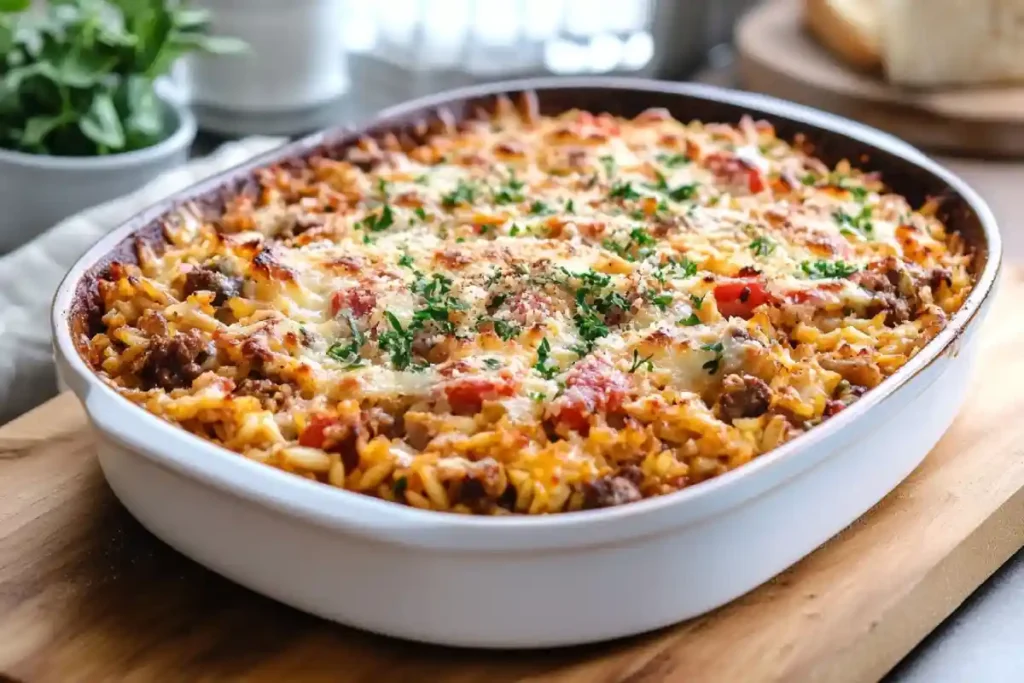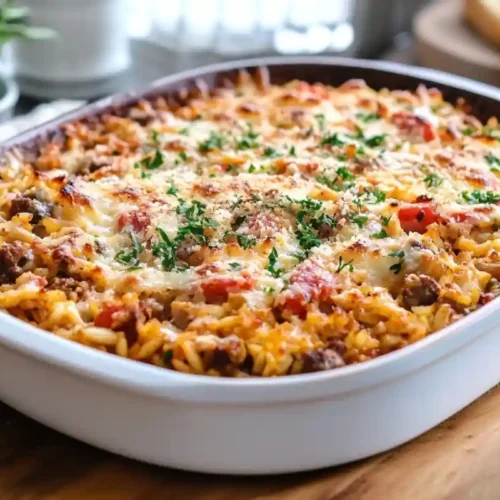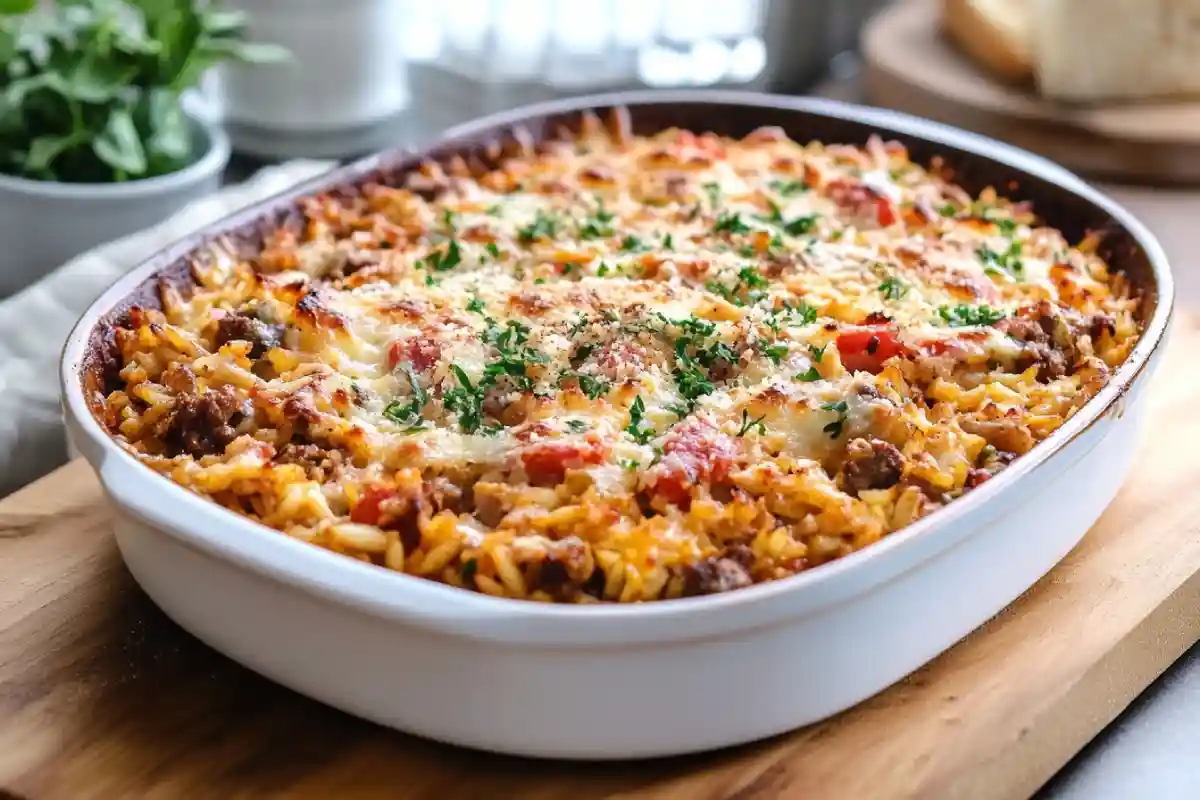
Table of Contents
Weeknight Cajun has never been easier: this baked jambalaya lets the oven do the simmering. After three sheet-pan trials, I locked in a 2 ¼-cup stock-to-rice ratio that keeps grains fluffy while shrimp stay juicy, delivering one-pan Louisiana flavor in just 50 minutes, hands-off.
What is Baked Jambalaya?
Baked jambalaya is a delicious variation of the classic Louisiana dish, known for its bold flavors and rich history. Unlike the traditional stovetop method, this version is cooked in the oven, allowing the ingredients to blend seamlessly while requiring less hands-on attention. The result is a perfectly cooked, flavorful rice dish packed with meats, seafood, and aromatic spices.
Origins and Cultural Significance
Jambalaya has deep roots in Cajun and Creole cuisine, two distinct cooking styles that define Louisiana’s food culture. While both versions share similar ingredients, their differences lie in preparation and seasoning. Cajun jambalaya is often darker and smokier due to the absence of tomatoes, whereas Creole jambalaya includes tomatoes, giving it a vibrant red hue. If you want to explore the traditional stovetop method, check out this authentic Louisiana jambalaya recipe, which showcases the dish’s classic preparation.
Why Choose the Oven-Baked Method?
Baking jambalaya has several advantages over the stovetop version, making it an excellent option for home cooks. Here’s why:
- Even Cooking: The oven ensures the rice cooks uniformly, preventing the risk of overcooked or undercooked grains.
- Hands-Free Process: Unlike stovetop jambalaya, which requires frequent stirring, baked jambalaya allows you to set it and forget it.
- Deeper Flavor: Slow baking enhances the flavors as the spices and ingredients meld together.
A Dish for Every Occasion
Whether you’re cooking for a family dinner or a festive gathering, baked jambalaya is a crowd-pleaser. Its versatility allows for endless variations, from traditional Cajun and Creole styles to modern twists like vegetarian or seafood options. Plus, it’s a great dish to prepare ahead of time since the flavors develop even more after resting.
Essential Ingredients for the Best Oven-Baked Jambalaya
To make the most flavorful baked jambalaya, using high-quality ingredients is key. Each component plays a crucial role in balancing spice, texture, and depth. Whether you’re making a classic version or experimenting with new flavors, these essential ingredients will help you achieve the perfect dish.
Key Proteins
Traditional jambalaya is known for its combination of meats and seafood. Here are the most popular options:
- Chicken – A mild and tender protein that absorbs spices well.
- Chicken Andouille Sausage – Adds a smoky, spicy depth to the dish.
- Shrimp – Common in Creole jambalaya, offering a sweet seafood flavor.
| Protein | Flavor Profile | Cooking Method |
|---|---|---|
| Chicken | Mild, absorbs spices | Sauté before baking |
| Chicken Andouille Sausage | Spicy, smoky | Brown in a pan first |
| Shrimp | Sweet, tender | Add at the end |
The Holy Trinity of Vegetables
No jambalaya is complete without the Holy Trinity, a staple in Louisiana dishes:
- Onion – Adds a natural sweetness and depth.
- Celery – Provides a mild, earthy balance.
- Bell Pepper – Contributes a hint of sweetness and color.
These vegetables form the aromatic base of baked jambalaya, infusing it with bold flavors.
Essential Spices and Seasonings
The perfect blend of spices can make all the difference. Be sure to include:
- Cajun or Creole Seasoning – A blend of paprika, garlic, onion powder, and cayenne.
- Thyme and Bay Leaves – Offer warmth and complexity.
- Black Pepper and Smoked Paprika – Enhance the dish’s depth and smokiness.
Best Rice for Baked Jambalaya
The type of rice you choose affects the texture of your dish.
| Rice Type | Texture Outcome | Best For |
|---|---|---|
| Long-Grain Rice | Light, fluffy | Traditional jambalaya |
| Parboiled Rice | Firm, separate grains | Prevents mushiness |
| Basmati Rice | Aromatic, non-traditional | Modern variations |
Since baked jambalaya cooks in a sealed dish with liquid, parboiled rice is ideal because it holds its shape and prevents a mushy texture.
Step-by-Step Guide: How to Make Baked Jambalaya
With all the essential ingredients ready, it’s time to combine them. This simple, step-by-step process ensures that your baked jambalaya turns out perfectly cooked, rich in flavor, and well-balanced in texture.
Step 1: Prep the Ingredients
Before cooking, make sure everything is ready to go:
- Chop vegetables – Dice onions, bell peppers, and celery.
- Slice meats – Cut Chicken sausage and chicken into bite-sized pieces.
- Measure seasonings – Have all spices and herbs ready to use.
Step 2: Sauté the Proteins and Vegetables
Cooking the base ingredients before baking enhances their flavors:
- Heat oil in a large skillet over medium heat.
- Brown the Chicken Andouille sausage, then remove and set aside.
- Cook chicken until lightly golden.
- Add the Holy Trinity (onion, celery, bell pepper) and sauté until soft.
- Stir in garlic, Cajun seasoning, and smoked paprika.
| Ingredient | Cooking Time | Purpose |
|---|---|---|
| Chicken Andouille Sausage | 3-4 minutes | Adds smoky flavor |
| Chicken | 5-6 minutes | Ensures tenderness |
| Holy Trinity | 4-5 minutes | Builds flavor base |
Step 3: Assemble the Dish for Baking
Once everything is cooked, transfer the ingredients to a baking dish:
- Stir in rice to coat it evenly with seasonings.
- Pour in chicken broth and diced tomatoes for moisture.
- Add bay leaves for additional depth.
Step 4: Bake to Perfection
- Preheat the oven to 350°F (175°C).
- Cover the dish with foil to trap steam.
- Bake for 40-45 minutes, stirring once halfway.
- Add shrimp in the last 10 minutes if using.
Step 5: Let It Rest & Serve
- Take the dish out of the oven and let it rest for 5 minutes.
- Discard bay leaves before serving.
- Garnish with fresh parsley and enjoy!
For another take on jambalaya, check out Alton Brown Jambalaya for an alternative cooking method and seasoning blend that may inspire your next dish.
Baked Jambalaya Variations
One of the best things about baked jambalaya is its versatility. Whether you prefer a classic approach or want to experiment with different ingredients, there’s a variation to suit every taste. Here are some of the most popular ways to customize this dish.
Cajun vs. Creole Baked Jambalaya
Although both styles are delicious, they have distinct differences:
- Cajun Jambalaya
- Does not include tomatoes, resulting in a brown, smoky flavor.
- Uses a darker roux to deepen the taste.
- Best suited for those who love earthy, robust flavors.
- Creole Jambalaya
- Contains tomatoes, giving it a rich red color.
- Offers a slightly sweeter and tangier taste.
- Ideal for those who enjoy a balance of spice and acidity.
Seafood Baked Jambalaya
If you love seafood, this variation is a great way to bring coastal flavors to your dish. Consider these options:
- Shrimp – Add in the last 10 minutes of baking to prevent overcooking.
- Crawfish – Provides an authentic Louisiana touch.
- Crab Meat – Offers a delicate, sweet contrast to the spices.
Vegetarian & Vegan Baked Jambalaya
For a plant-based take, substitute traditional proteins with:
- Smoked Tofu – Adds a firm texture and absorbs seasonings well.
- Plant-Based Sausage – Mimics the spiciness of Chicken Andouille sausage.
- Mushrooms & Chickpeas – Enhance the dish with earthy flavors and extra protein.
For a perfect side dish, try serving your baked jambalaya with olive salad, which adds a briny contrast that complements the bold spices.
Serving Suggestions & Storage Tips
Once your baked jambalaya is ready, serving it with the right sides and storing leftovers properly will ensure you get the most out of this delicious dish. Whether you’re preparing a casual dinner or a festive gathering, these tips will help you elevate the experience.
Best Side Dishes to Serve with Baked Jambalaya
To complement the rich and bold flavors of baked jambalaya, consider these tasty side options:
- Garlic Bread – A crispy, buttery side to soak up all the flavorful juices.
- Cornbread – Adds a slightly sweet contrast to the spiciness.
- Coleslaw – A refreshing, crunchy side that balances the heat.
- Grilled Vegetables – Offers a smoky and healthy addition to your meal.
- Cajun Green Beans – Infused with spices, these make a great Southern-style side.
How to Store Leftover Baked Jambalaya
Proper storage is essential to maintain the taste and texture of your dish. Follow these steps:
- Cooling: Let the dish reach room temperature before storing.
- Refrigeration: Store leftovers in an airtight container and keep them refrigerated for up to 3 days.
- Freezing: For longer storage, freeze in portioned containers for up to 3 months.
- Labeling: Always label the container with the date to track freshness.
Best Way to Reheat Baked Jambalaya
To keep your leftovers tasting as fresh as possible, use these reheating methods:
- Oven: Preheat to 325°F, place baked jambalaya in a covered dish, and heat for 15-20 minutes.
- Stovetop: Add a splash of broth and reheat over medium heat, stirring occasionally.
- Microwave: Use short bursts of heat, stirring in between to prevent uneven warming.
FAQs Section
As you prepare baked jambalaya, you may have some questions about the cooking process, ingredients, and texture. Below, we’ve answered some of the most common queries to help you achieve the perfect dish every time.
What temperature can you cook jambalaya in the oven?
Baked jambalaya should be cooked at 350°F (175°C) to ensure the rice absorbs all the flavors and cooks evenly.
What is the difference between Cajun jambalaya and Creole jambalaya?
Cajun jambalaya does not contain tomatoes, resulting in a brown color with a smokier flavor. Creole jambalaya, on the other hand, includes tomatoes, giving it a reddish hue and a slightly tangier taste.
What is the Holy Trinity of jambalaya cooking?
The Holy Trinity refers to a combination of onion, celery, and bell pepper, which forms the essential flavor base in both Cajun and Creole cuisine.
Is jambalaya supposed to be thick or soupy?
Jambalaya should be thick rather than soupy. The rice should fully absorb the liquid, creating a well-seasoned, slightly moist dish with a hearty consistency.
Conclusion
Baked jambalaya is a perfect blend of bold flavors, hearty ingredients, and effortless cooking. By using the right mix of proteins, vegetables, and spices, you can create a dish that captures the essence of Louisiana cuisine while enjoying the convenience of oven baking. Unlike traditional stovetop versions, this method allows for even cooking and deep flavor infusion without constant stirring.
Whether you prefer a classic Cajun-style jambalaya with a smoky, earthy taste or a Creole version with a rich tomato base, this dish can be customized to suit your preferences. You can also experiment with seafood, vegetarian alternatives, or different spice levels to make it your own. Regardless of the variation, the key to a great baked jambalaya is balancing the flavors while ensuring the rice absorbs just the right amount of moisture.
In addition to its delicious taste, baked jambalaya is a practical meal that can be prepared in advance, stored easily, and reheated without losing its quality. Whether you’re making it for a family dinner, a gathering with friends, or meal prep for the week, this dish is a reliable, flavorful option. With its deep-rooted history and versatility, it’s no wonder that jambalaya remains a staple in Southern cuisine.

Baked Jambalaya
Ingredients
- 2 Tbsp vegetable oil for sautéing
- 12 oz / 340 g andouille sausage sliced
- 1 lb / 450 g boneless chicken thighs 1-in cubes
- 1 — yellow onion diced
- 1 — green bell pepper diced
- 2 ribs celery diced
- 3 cloves garlic minced
- 1 ½ cups long-grain rice uncooked
- 1 14.5- oz can diced tomatoes with juices Creole style
- 3 cups low-sodium chicken broth
- 1 Tbsp Cajun or Creole seasoning adjust heat to taste
- ½ tsp smoked paprika
- ½ tsp dried thyme
- 2 — bay leaves
- ½ lb / 225 g raw shrimp peeled & deveined optional
- — to taste salt & black pepper
- 2 Tbsp fresh parsley chopped garnish
Instructions
- Preheat oven to 350 °F / 175 °C. Lightly grease the baking dish.
- Brown sausage in hot oil (3–4 min); transfer to dish. Sear chicken until lightly golden (5–6 min); add to dish.
- Sauté vegetables in the same skillet until softened (4–5 min). Stir in garlic, Cajun seasoning, paprika and thyme (1 min).
- Coat rice in the mixture, then pour in tomatoes, broth and add bay leaves. Bring just to a simmer.
- Bake covered for 40 min. Stir, fold in shrimp, re-cover and bake 10 min more, or until rice is tender and liquid absorbed.
- Rest 5 min. Discard bay leaves, adjust seasoning, garnish with parsley and serve hot.
Notes
- Cajun version: Omit tomatoes for a darker, smokier rice.
- Seafood option: Swap chicken for crawfish or add lump crab with the shrimp.
- Vegetarian twist: Replace meats with smoked tofu, plant-based sausage or mushrooms and use vegetable broth.
- Best rice: Parboiled rice holds its shape during the long bake and resists gumminess.

